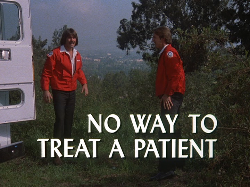No Way to Treat a Patient (Quincy, M.E.)
| No Way to Treat a Patient | ||||||||||||||||||||||||||||||||||||||
|---|---|---|---|---|---|---|---|---|---|---|---|---|---|---|---|---|---|---|---|---|---|---|---|---|---|---|---|---|---|---|---|---|---|---|---|---|---|---|

| ||||||||||||||||||||||||||||||||||||||
|
Episode Quote
"Sometimes it isn’t bullets that kill—it’s the incompetence covering them." ~ Dr. Quincy, in No Way to Treat a Patient (Quincy, M.E.)
Episode Overview
No Way to Treat a Patient is the twenty-second episode (season 5 finale) of Quincy, M.E., originally aired on NBC on April 29/30, 1980. In the episode, Quincy investigates whether the death of a gunshot victim was caused by medical malpractice or intentional foul play. The investigation involves his old classmate, Dr. Tony Carbo, who faces accusations of incompetence. :contentReference[oaicite:0]{index=0}
Table of Contents
Application of The QME Episode Laws
No Way to Treat a Patient exemplifies the four **QME Episode Laws**:
✅ **Law 1 – Seek Truth & Justice:** Quincy exposes irregularities in emergency treatment that may have caused the victim's death. :contentReference[oaicite:1]{index=1} ✅ **Law 2 – Social/Ethical Issues:** The episode explores medical ethics, highlighting the risk of unqualified physicians and the consequences for patient safety. :contentReference[oaicite:2]{index=2} ✅ **Law 3 – Sensitive Topics:** It handles the intersection of personal relationships and professional failure with tact, as Quincy works alongside a former friend. :contentReference[oaicite:3]{index=3} ✅ **Law 4 – Scientific Accuracy:** The autopsy findings—hemorrhages inconsistent with ER protocol—underscore the importance of forensic detail in determining cause-of-death. :contentReference[oaicite:4]{index=4}
Episode Synopsis
Following the arrival of a gunshot victim at an ER, Quincy discovers malpractice indicators during the autopsy—hemorrhage patterns and surgical missteps suggestive of substandard care. The attending physician, Dr. Tony Carbo, a Quincy classmate, is accused of mishandling life-saving procedures. Quincy and Sam piece together discrepancies between ER records and post-mortem findings. Amid a politically sensitive investigation, Quincy must navigate the delicate balance between friendship loyalty and professional responsibility, ultimately uncovering whether the victim’s death was due to negligence or deliberate cover-up. :contentReference[oaicite:5]{index=5}
Plot Summary
1. A uniformed ambulance delivers a gunshot victim; Quincy is called to examine the cause of death. 2. Autopsy reveals fatal hemorrhages and signs inconsistent with standard emergency care. 3. Records show Dr. Tony Carbo performed procedures at the ER—his credentials come under scrutiny. 4. Quincy interviews ER staff; conflicting reports emerge on whether mistakes or cover-up occurred. 5. Quincy confronts Carbo, exploring the pressures and errors that may have caused the death. 6. Forensic evidence pushes the investigation toward possible homicide via medical negligence or intentional action. 7. Carbo’s fate—license jeopardy or criminal culpability—remain central as Quincy follows the trail of evidence.
Main Cast
- **Jack Klugman** as Dr. R. Quincy
- **Robert Ito** as Sam Fujiyama
- **Garry Walberg** as Lt. Frank Monahan
- **John S. Ragin** as Dr. Robert Asten
- **Val Bisoglio** as Danny Tovo
- **Joseph Roman** as Sgt. Brill
Guest Cast
- **Ana Alicia** as Dr. Tony Carbo (credited in some sources as medical classmate) :contentReference[oaicite:6]{index=6}
- **A. Martinez**, **Duncan Gamble**, **Diana Webster** – ER staff & witnesses :contentReference[oaicite:7]{index=7}
Case File Summary
Victim: Unnamed male with a single gunshot wound Case #: LACC S5E22
The death looks like an ER tragedy but post-mortem examination suggests deeper errors or intentional omission.
Additional Victims
- No additional fatalities; the focus remains on malpractice and intent.
Alleged Perpetrator
- Dr. Tony Carbo – suspected of contributing to or covering up the victim’s death through incompetence or deliberate action.
Filming Locations
Studio sets reconstructed as a hospital ER, typical of season 5 production during 1979–80 in Los Angeles. No external location details available.
Forensic Science Insight
- Hemorrhage analysis distinguished between surgical trauma and initial gunshot damage.
- Comparison of ER documentation and autopsy findings highlighted wrongful omissions and oversight.
- Chain-of-custody concerns: Quincy presses for full medical record disclosure.
- This used forensic pathology to challenge institutional narratives—core tenet of the series.
Themes & Tropes
- **Medical Malpractice vs Murder** – Explores legal and ethical gray zones.
- **Friendship vs Duty** – Quincy’s relationship with Carbo tests his professional ethics.
- **Forensic Truth Over Authority** – Scientific evidence vs institutional cover-up.
- **Regulation and Accountability** – Raises questions about licensing and medical oversight.
Reception & Legacy
Received positive attention for spotlighting medical responsibility and trust in doctors. Fans appreciated Quincy’s integrity in balancing loyalty and justice. Plex rates it 7.3/10. :contentReference[oaicite:8]{index=8} It remains one of the stronger season finales, weaving tense personal drama with professional stakes.
Trivia
- A. Martinez appears early in his career as an ER doctor. :contentReference[oaicite:9]{index=9}
- The episode marks series finale for season 5, setting tone for medical-ethical storylines in later seasons. :contentReference[oaicite:10]{index=10}
Cultural Impact
No Way to Treat a Patient contributed to the broader conversation on medical ethics in prime-time TV, reinforcing Quincy’s role as both forensic pathologist and watchdog over institutional failures.
See Also
External Links
- IMDb – No Way to Treat a Patient :contentReference[oaicite:11]{index=11}
- TheTVDB – No Way to Treat a Patient :contentReference[oaicite:12]{index=12}
- Plex – No Way to Treat a Patient :contentReference[oaicite:13]{index=13}
- Quincy Examiner – QME Episode Laws
